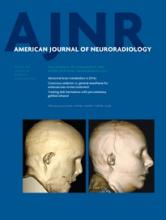We would like to thank Drs Wang and You for their thoughtful reading of our recent work and their comments. In response, we agree that a small minority of traumatic epidural hemorrhages may present without associated skull fracture or fracture that can be seen on CT, particularly in the pediatric population.1 In our experience with adult blunt head trauma at a major level I trauma center, this is a very rare occurrence. In our cohort of 12 patients with delayed epidural hematoma (DEDH) following decompressive craniectomy (DC), the sensitivity of contralateral fractures for DEDH was 100%.2 This result is not inconsistent with the rare incidence of epidural hematoma (EDH) without skull fracture. Technical specifications and the experience level of the interpreting radiologist are important factors in determining the sensitivity of CT for identification of skull fractures.
In a similar-sized cohort of patients, Su et al3 reported calvarial fractures in all 12 of their patients with DEDH. Two of these patients did not have identifiable fractures on CT but were noted to have fractures adjacent to EDHs intraoperatively. It is not clear whether calvarial fractures were apparent on retrospective review of the preoperative imaging in these 2 patients. Also in that study, CT parameters, including section thickness, were not described. Mohindra et al,4 in their review of the literature, reported calvarial fractures in 90% (17/19) of patients with DEDH after DC. Again, CT imaging parameters were not defined for this meta-analysis.
Results from our study are in line with these similarly powered studies, and our slightly higher sensitivity may relate to technical factors. For fracture evaluation, we used multidetector CT with bone algorithm reconstruction and a section thickness ranging from 0.625 to 1.25 mm. All calvarial fractures in our cohort of patients with DEDH were identifiable on the preoperative CT by board-certified neuroradiologists. Nevertheless, as Drs Wang and You suggest, a DEDH could escape the cautionary warning of a contralateral fracture due to the rare incidence of DEDH without fracture, inherent human error, and the limitations of even high-resolution CT.
Drs Wang and You also suggest that the specific location of calvarial fractures might be more important than the observation that contralateral fractures involve ≥2 bone plates, irrespective of location. This hypothesis is based on the supposition that EDH is mainly related to injury to the meningeal artery underlying the temporal and parietal calvaria. However, DEDHs may arise not only from injury to meningeal arteries but also from injury to meningeal veins or diploic veins within the bone or to venous sinuses. There is no anatomic predilection for injury to such veins or for the EDH that results from this injury. In our cohort, combined sensitivity and specificity were highest for patients with contralateral fractures involving ≥2 calvarial bone plates (sensitivity = 75%, specificity = 94%) compared with location-specific fracture patterns. For example, when fractures involving ≥2 bone plates in our cohort were analyzed by location, sensitivity and specificity, respectively, were 58% and 98% for parietotemporal, 8% and 97% for frontoparietal, and 33% and 97% for occipitoparietal involvement (unplublished data). Therefore, we emphasize the importance of identifying ≥2 contralateral calvarial fractures independent of specific bone involvement.2
Finally, we agree with Drs Wang and You's assertion that other risk factors, in addition to the presence of contralateral calvarial fractures on preoperative CT, may be predictive of a patient's risk for developing DEDH after craniectomy. Such insight may potentially be leveraged from the ongoing prospective clinical trial, Randomized Evaluation of Surgery with Craniectomy for Uncontrollable Elevation of Intra-Cranial Pressure, which is evaluating the role of decompressive surgery (unilateral or bilateral hemicraniectomy) for traumatic brain injury.5
REFERENCES
- © 2015 by American Journal of Neuroradiology











